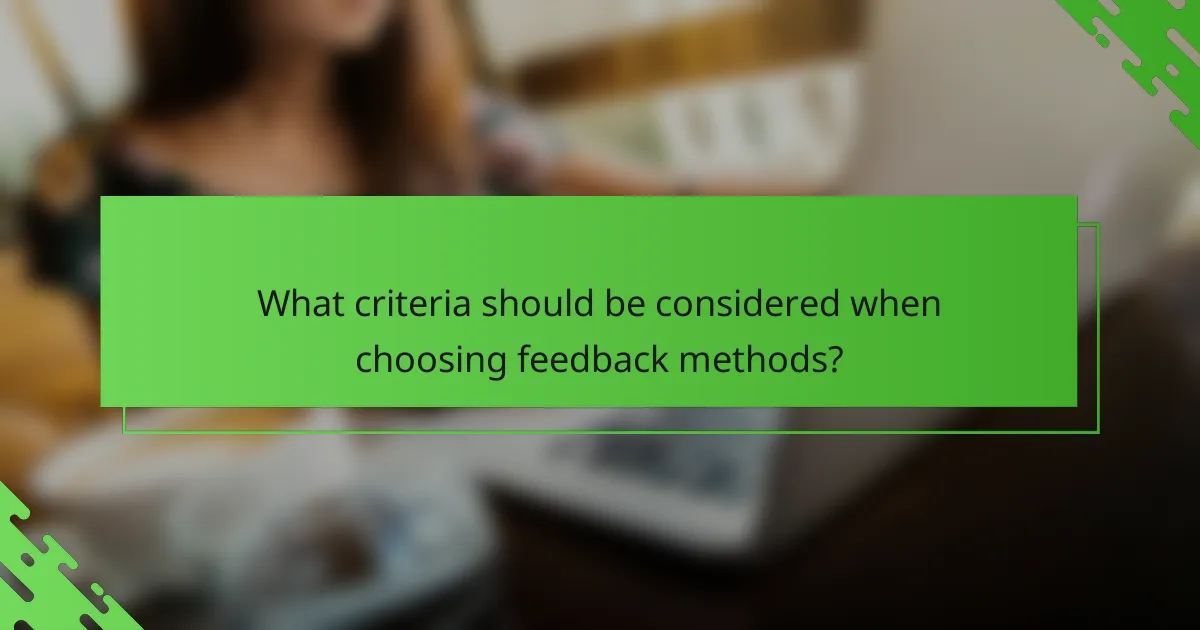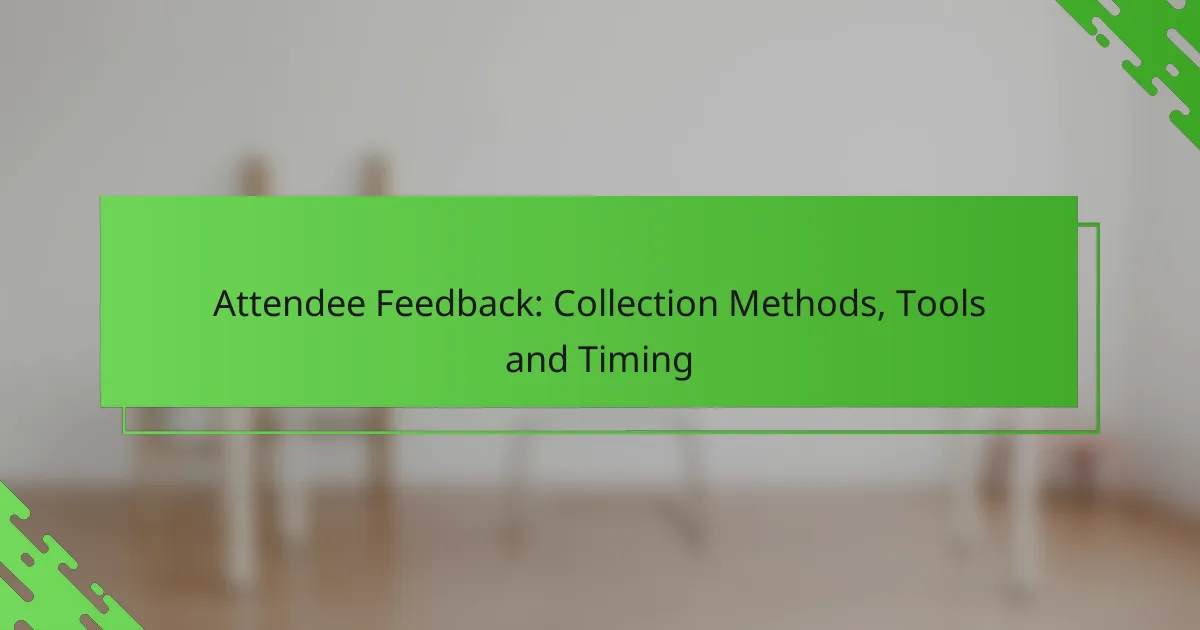Collecting attendee feedback is essential for improving future events and understanding participant experiences. Various methods such as surveys, focus groups, and live polls can be utilized, each offering distinct advantages depending on the context and goals. Selecting the right tools and timing for feedback collection is crucial to enhance response rates and gather meaningful insights.

What are the best methods for collecting attendee feedback?
The best methods for collecting attendee feedback include surveys, focus groups, interviews, live polls, and feedback kiosks. Each method has unique advantages and can be chosen based on the event context, desired depth of insight, and available resources.
Surveys and questionnaires
Surveys and questionnaires are effective tools for gathering quantitative data from a large number of attendees. They can be distributed online or in paper format, allowing for anonymity and ease of completion.
When designing surveys, focus on clear and concise questions. Use a mix of multiple-choice, rating scales, and open-ended questions to capture a range of feedback. Aim for a completion time of 5-10 minutes to maximize response rates.
Focus groups
Focus groups involve small groups of attendees discussing their experiences and opinions in a guided setting. This method provides qualitative insights and allows for deeper exploration of specific topics.
To conduct a successful focus group, select a diverse group of participants and prepare open-ended questions to facilitate discussion. Aim for sessions lasting 60-90 minutes to ensure thorough engagement without fatigue.
Interviews
Interviews offer a one-on-one approach to collecting feedback, allowing for in-depth conversations with attendees. This method is particularly useful for gathering detailed insights from key stakeholders or VIP guests.
Prepare a structured set of questions but remain flexible to explore unexpected topics. Keep interviews to 30-60 minutes to respect participants’ time while allowing for meaningful dialogue.
Live polls
Live polls enable real-time feedback during an event, making them ideal for gauging audience reactions instantly. They can be conducted through mobile apps or audience response systems.
To implement live polls effectively, ask clear and concise questions that can be answered quickly. Use them to spark discussions or adjust the event flow based on attendee preferences.
Feedback kiosks
Feedback kiosks provide a physical location for attendees to submit their thoughts at the event venue. These can be set up with tablets or computers, allowing for quick and easy input.
Ensure kiosks are strategically placed in high-traffic areas and are user-friendly. Offering incentives, such as entry into a prize draw, can encourage more attendees to participate in providing feedback.

Which tools are effective for attendee feedback collection?
Effective tools for attendee feedback collection include online survey platforms that streamline the process and enhance response rates. Choosing the right tool depends on your specific needs, such as ease of use, customization options, and integration capabilities.
SurveyMonkey
SurveyMonkey is a popular survey tool known for its user-friendly interface and extensive template library. It allows event organizers to create customized surveys with various question types, including multiple-choice and open-ended questions.
Consider using SurveyMonkey for its robust analytics features, which help in interpreting feedback. The free version offers basic functionalities, while paid plans provide advanced options like logic branching and data exports.
Google Forms
Google Forms is a free tool that integrates seamlessly with other Google Workspace applications. It enables users to create simple surveys quickly and share them via links or email.
This tool is ideal for those on a budget, as it offers unlimited responses and easy collaboration with team members. However, it may lack some advanced features found in dedicated survey tools, such as detailed analytics.
Typeform
Typeform stands out for its visually appealing and interactive survey designs, which can enhance user engagement. The platform allows for a conversational style of questioning, making it more inviting for respondents.
While Typeform offers a free tier, its premium plans unlock advanced features like conditional logic and integrations with other software. This tool is particularly effective for events that prioritize user experience in feedback collection.
Eventbrite
Eventbrite not only serves as a ticketing platform but also provides built-in tools for collecting attendee feedback. After an event, organizers can send automated surveys to participants, making it convenient to gather insights.
Using Eventbrite for feedback collection is beneficial for those already utilizing the platform for event management. However, the feedback features may be less customizable compared to dedicated survey tools.
Slido
Slido is designed for live events, allowing real-time audience engagement through polls and Q&A sessions. This tool is particularly effective for gathering immediate feedback during presentations or workshops.
Slido’s integration with popular video conferencing tools enhances its usability for virtual events. While it excels in live interactions, it may not be the best choice for comprehensive post-event surveys, as its focus is on real-time engagement.

When is the optimal timing for collecting feedback?
The optimal timing for collecting feedback is crucial for obtaining accurate and actionable insights. Gathering feedback immediately after an event, during the event, or through follow-up emails can significantly impact response rates and the quality of the information collected.
Immediately after the event
Collecting feedback immediately after the event is often the most effective method. Attendees are still engaged and their experiences are fresh in their minds, which can lead to more detailed and accurate responses. Utilize quick surveys or feedback forms to capture their thoughts while the event is still top of mind.
Consider using mobile-friendly surveys or QR codes that link to feedback forms to make it easy for attendees to respond on the spot. Aim for a response rate of at least 30-50% by incentivizing participation with small rewards or entry into a raffle.
During the event
Gathering feedback during the event allows for real-time insights that can be immediately addressed. Use interactive tools like live polls or feedback kiosks to engage attendees and collect their opinions on various aspects of the event as it unfolds.
Keep questions concise and focused to encourage participation. For example, ask attendees to rate speakers or sessions on a scale of 1 to 5. This immediate feedback can help organizers make on-the-fly adjustments and improve the overall experience.
Follow-up emails
Sending follow-up emails is a valuable method for collecting feedback after the event has concluded. This approach allows you to reach attendees who may not have had the time to provide feedback immediately. Aim to send these emails within a few days of the event to ensure the experience is still fresh.
Include a brief survey link in the email and keep it short, ideally under 5 questions. Personalize the email to increase engagement and consider offering a small incentive for completing the survey, such as a discount on future events or exclusive content access.

What criteria should be considered when choosing feedback methods?
When selecting feedback methods, consider factors such as audience demographics, the type of event, and the desired depth of insights. These criteria help ensure that the feedback collected is relevant, actionable, and tailored to your specific needs.
Audience demographics
Understanding your audience demographics is crucial for choosing effective feedback methods. Consider factors such as age, cultural background, and technological proficiency, as these can influence how attendees prefer to provide feedback. For instance, younger audiences may favor digital surveys, while older attendees might prefer paper forms.
Additionally, segmenting your audience can help tailor your approach. For example, if your event attracts both professionals and students, you might use different feedback tools for each group to maximize engagement and response rates.
Event type
The type of event significantly impacts the choice of feedback methods. For large conferences, online surveys may be more efficient, while smaller workshops might benefit from in-person feedback sessions. Consider the format and goals of your event when deciding how to gather insights.
Moreover, the timing of feedback collection is essential. For instance, immediate post-event surveys can capture fresh impressions, while follow-up surveys a few weeks later can provide deeper insights into long-term impact. Align your feedback methods with the event type to enhance relevance and effectiveness.
